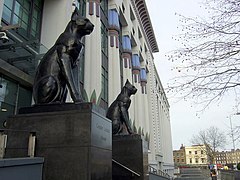Greater London House
| Carreras Factory | |
|---|---|

The black cats on guard in front of the building
|
|
| Alternative names | Arcadia Works Greater London House The Black Cat Factory |
| General information | |
| Type | Former cigrarette factory converted for office use |
| Architectural style | Art Deco Egyptian Revival |
| Location | Mornington Crescent, Camden Town |
| Address | Greater London House, 180 Hampstead road, London NW1 7AW |
| Town or city | London |
| Country | England, UK |
| Coordinates | Coordinates: 51°32′01″N 0°08′23″W / 51.5335°N 0.1398°W |
| Current tenants | British Heart Foundation, Young & Rubicam advertising agency, ASOS.com, Wunderman, WPP, Radley & Co and others |
| Construction started | 1926 |
| Completed | 1928 |
| Renovated | 1996 |
| Design and construction | |
| Architect | M.E Collins, O.H Collins & A.G Porri |
| Renovating team | |
| Renovating firm | Finch Forman |
| Awards and prizes | Civic Trust Award |
The Carreras Cigarette Factory is a large art deco building in Camden, London in the United Kingdom. It is noted as a striking example of early 20th Century Egyptian Revival architecture. The building was erected in 1926-28 by the Carreras Tobacco Company owned by the Russian-Jewish inventor and philanthropist Bernhard Baron on the communal garden area of Mornington Crescent, to a design by architects M.E and O.H Collins and A.G Porri. It is 550 feet (168 metres) long, and is mainly white,
The building's distinctive Egyptian-style ornamentation originally included a solar disc to the Sun-god Ra, two gigantic effigies of black cats flanking the entrance and colourful painted details. When the factory was converted into offices in 1961 the Egyptian detailing was lost, but it was restored during a renovation in the late 1990s and replicas of the cats were placed outside the entrance.
As demand for cigarettes increased during the First World War, the Carreras Tobacco Company expanded its business in the 1920s, like many other tobacco companies. Carreras had outgrown its Arcadia cigarette factory in City Road, London, so it closed the facility and opened a new Arcadia Works in 1928 in Mornington Crescent, Camden.
The architects of the Camden Arcadia Works were Marcus Evelyn Collins and O.H. Collins, along with Arthur George Porri (1877-1962) who adapted the Collins plans. The design was greatly influenced by the contemporary fashion for Egyptian-style buildings and decorative arts. The Carreras building was designed four years after Howard Carter's 1922 expedition which uncovered the tomb of Tutankhamun, which had popularised Egyptian themes in the minds of many Art Deco architects at the time. The vogue for Egyptian Art Deco was also aroused by architectural displays at the Paris Exhibition of 1925, as well as various spectacular Hollywood portrayals of Ancient Egypt. Collins, Collins and Porri additionally drew inspiration from the displays at the British Museum. Commentators on the architecture have also speculated that the use of Egyptian decoration was used to create an association of the "luxury" image of smoking with the treasures of Ancient Egypt.
...
Wikipedia
